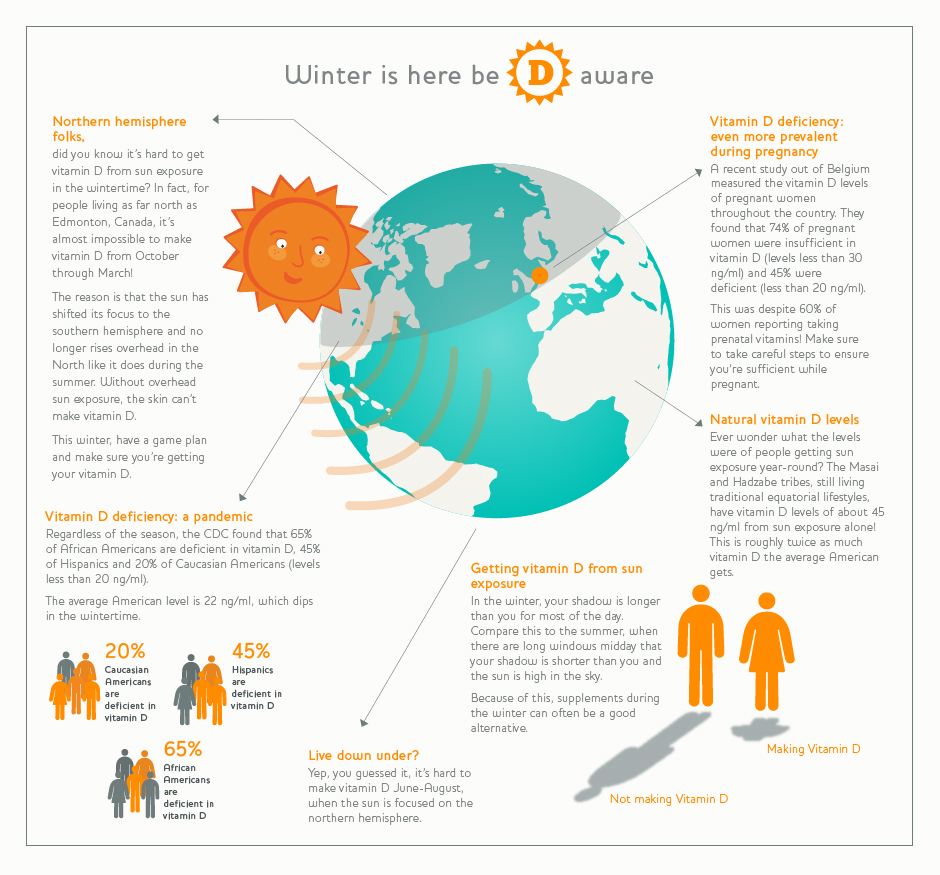
Most know that vitamin D does not come from your diet, but rather from your skin when you expose it to the sun.
What most people don’t know is that in the wintertime it’s hard to make vitamin D. As November approaches, the sun shifts its focus on the southern hemisphere and is no longer shining overhead in the North.
What does this mean? It means that your skin is no longer able to produce much vitamin D. This November 2nd, learn more about vitamin D, deficiency and taking care of yourself in the winter.
About vitamin D

Research shows that vitamin D is likely important beyond just bone health, for functions like heart health, cancer protection, the nervous system, immunity and mental health.
Vitamin D is a nutrient that your own body produces! When you expose your skin to the sun, you produce vitamin D, lots of it. On the other hand, it is not found in large quantities in food. This makes vitamin D unique and complex in getting the right amount.
Vitamin D is essential in maintaining calcium and keeping your bones strong. But vitamin D is also important for cell communication throughout your body, giving your cells the nutrient they need to communicate with each other. Research is ongoing, but to date it appears that vitamin D may be important for:
- bone health
- cardiovascular health
- cancer protection
- the nervous system
- immunity
- mental health
That is why deficiency in vitamin D has been linked to all kinds of diseases, including many cancers, multiple sclerosis, heart diseases, influenza, asthma, bone disease and more.
Am I getting enough vitamin D?
Probably not! To be sufficient in vitamin D, you have to live a true outdoor lifestyle or you have to supplement on a regular basis. Risk factors for vitamin D deficiency include:
- indoor lifestyle
- living at high-latitudes during the winter
- too much clothing
- use of sunscreen
- darker skin
- obesity
- older age
Yep, you read it right! An indoor lifestyle puts you at risk for vitamin D deficiency. And in the wintertime, you’re at even greater risk of vitamin D deficiency. Even when you do get outside, the sun doesn’t get quite overhead enough to let your skin produce vitamin D.
This winter, take action, make sure you get your vitamin D

While you can get vitamin D from sun exposure during the summer, supplementing during the winter is a good strategy to get the vitamin D your body needs.
Throughout the year, you can normally get your vitamin D by sun exposure primarily, supplementation on days you don’t get sunshine, and with food, though there are very small amounts of vitamin D in food.
As we have explained, it’s a little harder in the winter to make vitamin D from sunshine. Says Professor Reinhold Vieth, “If you expect sunshine to provide you with vitamin D, then make sure your shadow is shorter than your height. The long shadow we see in November is proof the sun is not doing it for us any more, and it’s time to take care of ourselves.”
So thus, supplementing with vitamin D in the winter is a good alternative to sun exposure. There is a panel of 42 of the world’s leading vitamin D researchers that recommend the serum levels of 100-150 nmol/L. See grassrootshealth.net or vitamindcouncil.org for more information on supplementing with vitamin D.
What about vitamin D in food?
There are small amounts of vitamin D in a few foods, which makes it nearly impossible to get what you need from food. Lots of experts believe that trying to get enough vitamin D from your diet is unlikely to give you the vitamin D you need.
Hey, what about sun exposure?
Safe and moderate sun exposure is the preferred way to get the vitamin D you need, but not always achievable in many populated parts of the world November-March. Thus you need to supplement in the winter, especially those living in Canada, the upper half of the United States and similar latitudes.
Come spring time, however, make sure to take advantage of the sun and your own ability to make vitamin D. If your shadow is shorter than you are, you are making vitamin D. Use safety and moderation and don’t burn! In fact, in just half the time it takes to turn pink, your body can produce 10,000 IU of vitamin D!
How do I know if I am getting enough vitamin D?
Having a blood test to measure the amount of vitamin D in your blood is the only way to know if you’re getting enough vitamin D or not. The blood test you need is called a 25(OH)D blood test.
You can get a blood test at your doctor’s or you can do an in-home test. Either method of testing should give you accurate results. Your results will be in nmol/l (or in ng/ml if you live in the United States).
Different organizations recommend different levels and there is a little debate on what level is optimum. However, most agree that many people are not getting enough vitamin D and their blood levels show this.
Visit grassrootshealth.net or vitamindcouncil.org for more information on testing and recommendations.
What’s the conversion from nmol/l to ng/ml?
To get from nmol/l to ng/ml, the formula is simply [nmol/l] ÷ 2.5 = [ng/ml].
For example a level of 60 nmol/l is equal to 60 ÷ 2.5 = 24 ng/ml.
Further recommendations
This was a quick summary, we encourage you to learn more. You can visit the Vitamin D Council or GrassrootsHealth sites for further recommendations.
